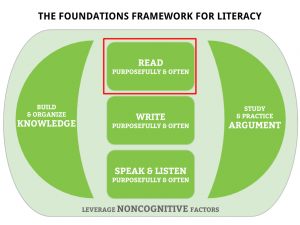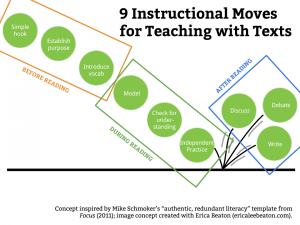I can't get the image of the nursing professor out of my head. I was at Davenport University in a panel session for professors there, and I was representing high school education. During the Q & A, this professor in the nursing program stood up and asked the following questions:
“Why can't students teach themselves through reading? Every semester, I have kids who come to me asking for the study guide, and when I tell them that their task is to study and learn the material in a certain section of the textbook, they look at me bewildered. So, again, my question is: Why aren't college students able to learn from reading?”
My answer — which is liable to be wrong, so take it for what it is — is twofold: first, they aren't given enough opportunities to learn from reading; and second, they aren't adequately taught how to learn from reading.
Quantity First

In my literacy workshops for secondary teachers, I start the Reading Purposefully and Often module (see Figure 1) with a simple “Give Me a Number” exercise: Quantify how much reading every student is given in every course you teach. I find that this cuts past debates about how to fit more reading into the content areas because it starts with undebatable data: point blank, how much reading is already expected, for every child? Interestingly enough, this exercise is often enlightening for English Language Arts teachers, too.
From this exercise flows a logical question: Okay, now that we have a quantity, do we agree that the number of texts students are expected to read in all of our courses is the highest that it can be? Or: Is there any way we could teach the same knowledge and skills while also providing kids with more opportunities to read? Or, bluntly: Is this the best we can do?
Here, strategies like Gallagher's article of the week or Turner's graph of the week offer efficient entry points into significantly increasing the quantity of reading opportunities without drastically increasing the time taken for it.
To use a sports metaphor, all that we're doing at this point is deciding how many reading practice sessions all of our kids are guaranteed to have. Until this happens, the quality of those practices is somewhat irrelevant.
Quality Next (this is where we try teaching them to read actively, learnfully, successfully)

The quantity exercises above are really triage work — these are the lowest hanging fruits for moving the needle on reading achievement; they establish conditions in which readers can grow.
Once this triage work is done, it's time to attend to the long-term quality of a school's work around reading, and this is where the nine moves for teaching with texts come in. (See Figure 2.) Specifically, if we go back to the Davenport professor's concern, when our purpose is to have students learn through reading — like last night, when my APWH kids learned about the Ming dynasty, or last week, when my regular World History kids read about the Atlantic System's Triangular Trade Routes — we need to work at clearly communicating that purpose and then modeling what “reading to learn” looks like.
Anna's Example
The other day after school, I was working with Anna on her study habits, and she and I were looking over her notes. I asked her a series of questions: “So what does it look like when you are taking these notes. How do you decide what to write down? When do you do the note-writing? Every paragraph? Every page? Every sentence?”
“Well,” she said, “When I read something that I think I should write down, I write it down.”
This was an epiphany for me. Here I had a hard-working kid, a kid who does her reading consistently, a kid who fully wants to succeed and believes she can succeed and feels like she belongs (in short, she has the four academic mindsets), but she was still doing the reading primarily because it was something she had been told to do. For her, doing the reading was “learning as duty” — and while that is an important conception of learning, it's not a good one when we're helping kids learn to learn from reading.
Instead, the stance we want kids to take when approaching a reading to learn task is, “Okay, right now I am a student of this text, and my job is to learn as much as I can from it. I can ask questions of this teacher-text, but it's only going to answer with itself. I can also ask questions of other sources — ‘Google, define bellicose' — and I can ask my peers or Mr. Stuart tomorrow if I get stuck beyond that.”
There are other ways of communicating the kind of “reading to learn” we're aiming for here — Adler and VanDoren call it “active reading” (see #3 here) in their seminal How to Read a Book; noncognitive factors researchers call it self-regulated learning — and, from what I can tell, all of these are good. It is likely that, when modeling and communicating this kind of intensely internal work, we're smart to do it in as many ways as possible so as to increase the odds that as many learners as possible will internalize and master it.
In sum
The quantification work is just the doorway into enhanced reading achievement for our kids. Once we ensure that a certain volume of reading will be expected across the school day — and that a large share of that reading in the content areas will be reading to learn — then we can engage with the deep and challenging work of scaffolding that reading as expertly as possible using the nine simple, robust moves for teaching with texts.
Leave a Reply